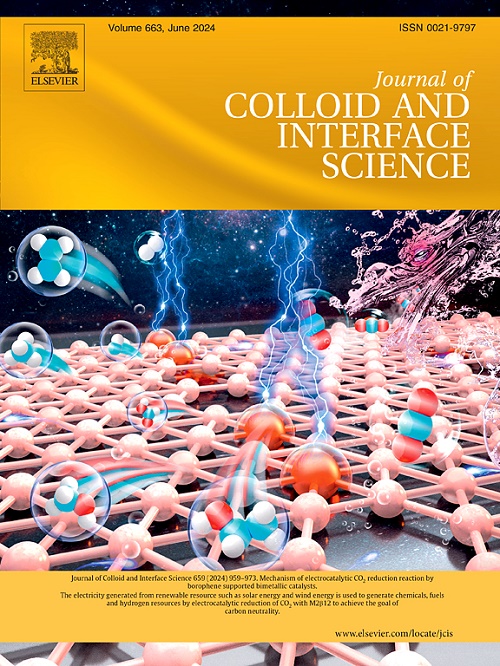Building hydrophobic substrate pocket to boost activity of laccase-like nanozyme through acetonitrile-mediated strategy
IF 9.4
1区 化学
Q1 CHEMISTRY, PHYSICAL
引用次数: 0
Abstract
Nanozymes, as promising alternatives to natural enzymes, offer several advantages with biocatalytic functions but remain inferior in catalytic activity. It is crucial to focus on factors that affect the enzymatic activity of nanozymes and develop strategies to make them more competitive with natural enzymes. Herein, CuV2O5 nanorods are confirmed to own the intrinsic laccase-like activity, and an acetonitrile (MeCN)-mediated strategy is proposed for reaction acceleration by mimicking the enzymatic substrate pocket. In the presence of MeCN, the interaction between substrates and nanozymes gets efficiently promoted by the bridging function of cyano-group, where the utilization of Cu active sites is greatly improved due to the condensed hydrophobic substrate layers formed in the vicinity of CuV2O5 nanorods by the solvent effect of MeCN. Theoretical calculations also disclose that the addition of MeCN endows 2,4-dichlorophenol (2,4-DP) with a lower free-energy barrier in adsorption and activation on the surface of CuV2O5 nanozyme. Benefiting from the improved activity, a sensitive colorimetric sensing platform for 2,4-DP is constructed with the limit of detection as low as 0.48 μM. Our finding lays a theoretical foundation for achieving high-performance catalytical activity of the nanozymes based on the modulation of the reaction microenvironment, effectively alleviating the complex engineering process of nanozymes.

通过乙腈介导策略建立疏水性底物口袋,提高类漆酶纳米酶的活性。
纳米酶作为天然酶的有前途的替代品,在生物催化功能方面具有若干优势,但在催化活性方面仍然逊色。因此,关注影响纳米酶酶解活性的因素并制定策略使其与天然酶相比更具竞争力至关重要。本文证实了 CuV2O5 纳米棒具有类似漆酶的内在活性,并提出了一种乙腈(MeCN)介导的策略,通过模拟酶底物口袋来加速反应。在 MeCN 的存在下,底物与纳米酶之间的相互作用因氰基的架桥功能而得到有效促进,由于 MeCN 的溶剂效应在 CuV2O5 纳米棒附近形成了疏水底物凝结层,从而大大提高了铜活性位点的利用率。理论计算还表明,加入 MeCN 后,2,4-二氯苯酚(2,4-DP)在 CuV2O5 纳米酶表面的吸附和活化自由能垒更低。得益于活性的提高,我们构建了一个灵敏的 2,4-DP 比色传感平台,其检测限低至 0.48 μM。我们的发现为基于反应微环境调控实现纳米酶的高性能催化活性奠定了理论基础,有效缓解了纳米酶工程化过程的复杂性。
本文章由计算机程序翻译,如有差异,请以英文原文为准。
求助全文
约1分钟内获得全文
求助全文
来源期刊
CiteScore
16.10
自引率
7.10%
发文量
2568
审稿时长
2 months
期刊介绍:
The Journal of Colloid and Interface Science publishes original research findings on the fundamental principles of colloid and interface science, as well as innovative applications in various fields. The criteria for publication include impact, quality, novelty, and originality.
Emphasis:
The journal emphasizes fundamental scientific innovation within the following categories:
A.Colloidal Materials and Nanomaterials
B.Soft Colloidal and Self-Assembly Systems
C.Adsorption, Catalysis, and Electrochemistry
D.Interfacial Processes, Capillarity, and Wetting
E.Biomaterials and Nanomedicine
F.Energy Conversion and Storage, and Environmental Technologies

 求助内容:
求助内容: 应助结果提醒方式:
应助结果提醒方式:


